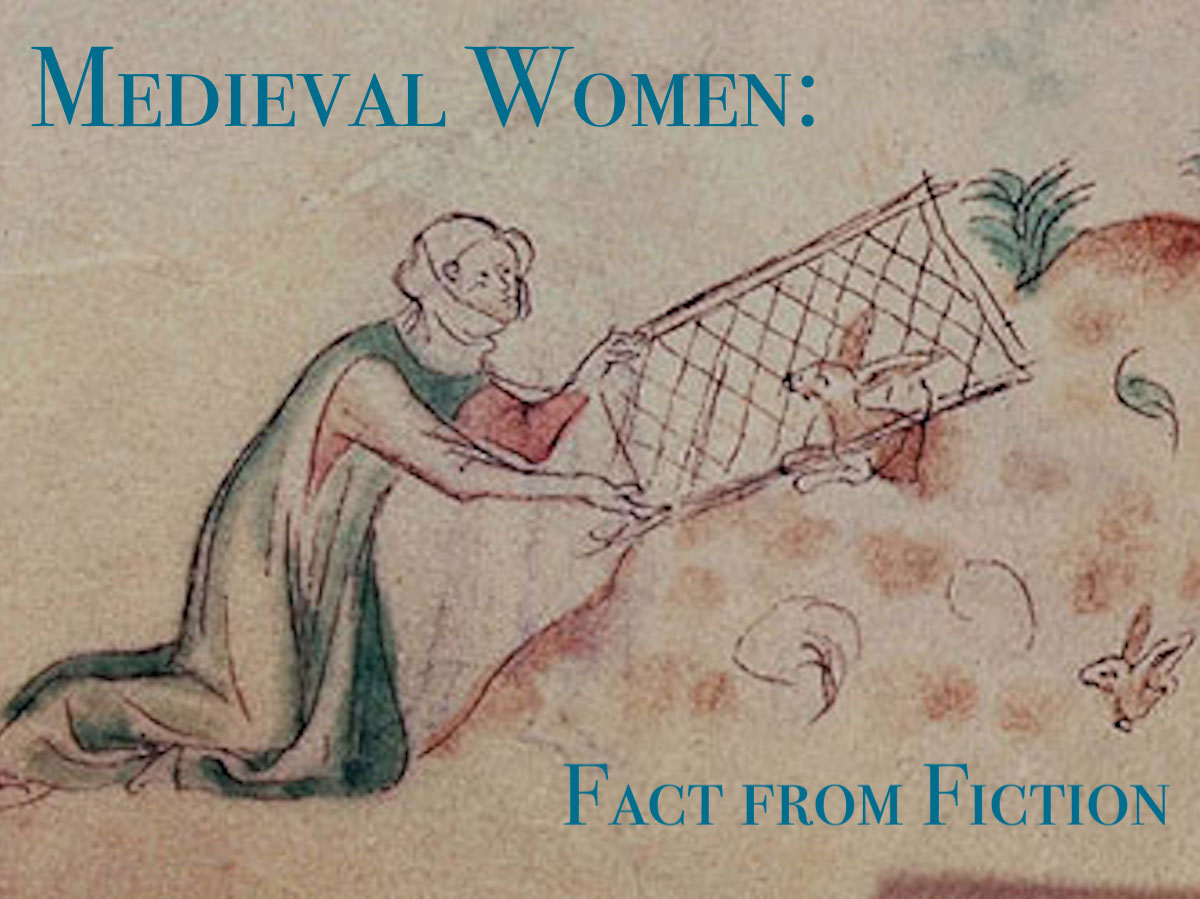Two things the modern history nerd needs to be wary of in their historical thoughts and pursuits are prejudice and its sneaky little brother, the stereotype. Watch any popular historical film and some stereotype or other will show its head. In this article, I’ll be discussing the stereotype of medieval women in Europe. Were they really just helpless damsels in distress, or was there more to these women than met the eye? Let’s take a deeper look at the various roles and identities of two European women in the Middle Ages to dispel some fact from fiction.
First, consider the medieval noblewoman. From what fictional portrayals show, her natural happy state would be as the wife of a nobleman. We see so many medieval woman as powerless figures who rely on their husbands for everything from money to protection, even as far as needing a male figure to make decisions for them on a day to day basis. Yet, if we look at the case of Eleanor, Countess of Leicester, we can see that marriage was quite the opposite of safe and comfortable. Eleanor, who was the daughter of John I, never met her father, as he died when she had just turned one year old. She was promised to the son of the infamous knight, William Marshal, who was also named William. They married in 1224, when William was thirty-four and Eleanor just nine. William died just seven years later. There were no children, and according to English custom at the time, the marriage wouldn’t have been consummated until Eleanor was old enough to bear children. Though Eleanor had entered a nunnery after her first husband’s death and took a vow of chastity, she went on to marry another man, Simon de Montfort, seven years later. They had seven children together.

Eleanor left a good amount of evidence behind in the form of letters and her household register from the year 1265: a record of her expenditures, the food she and her guests ate, the clothing she wore, household furnishings and their repair, as well as money she sent for war efforts. Her letters show her to have had a bit of a temper, and she seems to have quarreled with her husband regularly. She and her husband were not together for long periods of time during their marriage, he being occupied with matters of state and the Second Barons’ War. The couple maintained separate households more often than not, and this stretched finances a great deal. At one point, however, Simon comes home—and brings three hundred horses and as many men with him to her household of sixty servants that was used to housing up to thirty horses. This was a bit worse than “honey, I brought the boss home for dinner!” Eleanor’s husband also led a revolt against her own brother, the king Henry III. Because of this, they had to flee from one castle to another during this time, and eventually she had to go into exile in France when her husband and one of her sons were killed. We don’t know from the record we have what Eleanor’s true feelings about this revolt were, but her married life was quite chaotic and dangerous. Even having seven children at the time was dangerous for a woman, all the rest of it aside.
But what about the lives of widows? In our current society, we often think of widows as older women, grieving, maybe someone frail. In the Middle Ages, our stereotypes seem to point to someone who needs protection. If the widow was younger, we often see her married off immediately in pop culture portrayals, with little or no say in the matter. Life in actuality wasn’t always like this, however.
Some evidence shows that widowed life was easier for a woman than married life. Widows, at least in England, got the rights back to lands and properties they owned before they were married. Plus, they could continue to receive a third of the rent of their deceased husband’s lands as well. Especially for a woman of nobility, this meant she didn’t need a husband to protect her—she had money to do that. In fact, many noblewomen paid off the king to discourage him from trying to match her up with one of his connections, so she could stay unmarried. Wealthy women were indeed a sought-after commodity (it was one way a man of middle means could raise his status), but they did have some agency in the matter. Widows were often very young, much like Eleanor was. With illness and war, a husband’s longevity was not a sure thing. Widowhood could be a dignified position where a woman could become a patron of things like religion or the arts, and use her money to improve the lives of others.

Elizabeth de Burgh (also known as Elizabeth de Clare) was a wealthy heiress from the time of her youth, being a granddaughter of Edward I of England. She first married when she was thirteen, then was widowed at eighteen. Because of her youth and her position as an heiress, she was seen as a valuable commodity. Her life is like something out of a gothic novel. She was kidnapped, married, widowed again, married again, and then was held prisoner by her brother-in-law in order to make her surrender her lands to him. Her life was tumultuous to say the least, all because of her property. As soon as she was safe and her property restored to her, she left married life behind forever and moved to Clare Castle, where she lived in happiness, so far as we can tell, afterwards. She welcomed family and friends to stay with her, and she used her money to found Clare College in Cambridge. From the evidence we have, de Burgh was certainly happier as a widow than as a married woman.
But what about another state of womanhood that we seen on movies and in books all the time, the “wanton prostitute?” Fiction and stereotypes show medieval prostitutes as being anywhere from jovial to downtrodden, but not usually very clean, and often diseased. Today in our society we tend to see prostitution as taboo. Back when religion was much stricter than it is today, shouldn’t it have been even more so?
Not entirely. In many, if not most, cases, prostitution was just a part of medieval life, something that was pretty much taken for granted. Medieval men and women were ambivalent about it, and in fact, clergy found themselves in a conundrum when looking at Mary Magdalene, who was most often portrayed as a prostitute at the time, and pondered what the morality of prostitution was, since Jesus accepted her as a follower and she was considered a holy person. Another concern the clergy had was if prostitutes should tithe, since their earnings were the fruit of sin.
Rather than prostitution being forbidden in ordinary medieval life, many people thought it was necessary to maintain social order, to give rowdy men something to do. In London, there is evidence that the bishop’s officials were charged with making sure brothels were clean and orderly, and that women weren’t being held there against their will. Prostitutes seemed to have been an accepted part of society, and were not looked down upon as much as they were in other times in history. At the very least, they had some protections. They were providing a service, making business transactions.

While the examples I discuss above are certainly not all encompassing, and we don’t have records for how everyone, especially peasants, lived at the time, we can see that women could be far from damsels in distress, even when they were kidnapped or widowed while on the wrong side of a war. Relying on stereotypes when considering another time can be dangerous, because so often those stereotypes are an invention of a later time. If we want to know how people truly lived, instead of imagining a fantasy, we need to look at actual evidence when we can. Household records, bills, diaries, and letters are all very helpful, though they only tell the tales of a small percentage of the people, the literate and wealthy. Archeological evidence can also be helpful.
So what is an accurate yet fictional portrayal of a medieval woman in Europe? Immediately, Cate Blanchett’s portrayal of Marian Locksley in Ridley Scott’s 2010 film Robin Hood comes to mind. Her husband left her years before, after having only been married for a very short time, to go crusading with Richard I. She had a blind father-in-law to care for and a village of people who were left without a strong steward. Rather than the Disney princess-like figure of Marian that many other movies show, Blanchett’s Marian is in the fields working with the people, hearing their pleas, and negotiating with the Church and the sheriff for better conditions and help. She takes no crap, yet she’s not unrealistically endowed with power. Part of her appeal is that we can see what a hard time she is having, and we can sympathize with her as much as we admire her.
Sometimes, historical stereotypes can be fun, and indeed, I love watching medieval movies, inaccurate or not, as much as the next history nerd. But if you don’t follow up your enjoyment with a little digging into how things really were for the characters in your favorite tales, you are missing half the story.
Further Reading:




